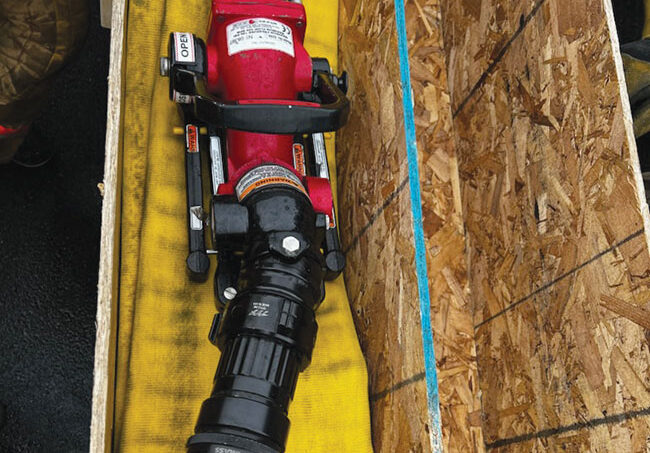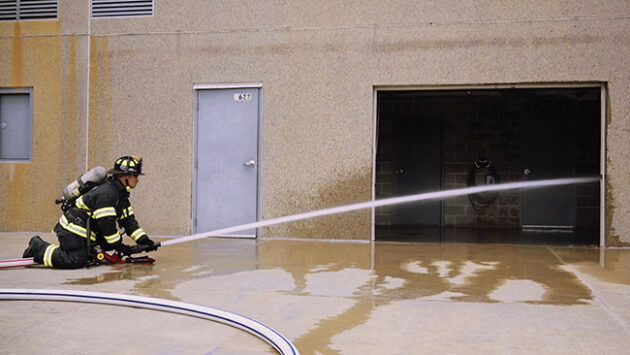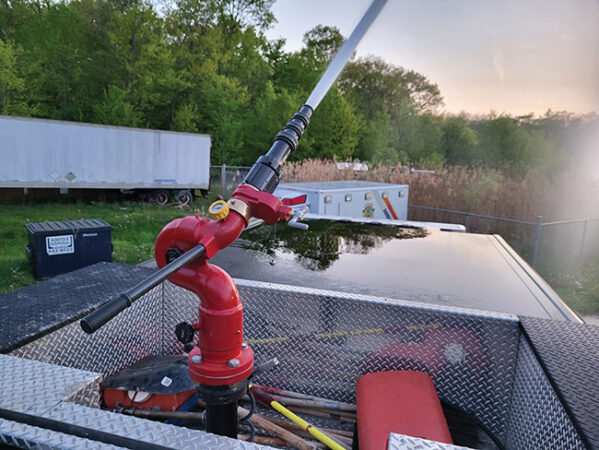
Features
Training
Back to Basics: Garage fires, Part 5
July 25, 2023
By Mark van der Feyst
 Photo 1: A RAM can be preconnected to a 65 millimetre or two-and-a-half-inch hose line for rapid deployment by one firefighter.
Photos by Mark van der Feyst
Photo 1: A RAM can be preconnected to a 65 millimetre or two-and-a-half-inch hose line for rapid deployment by one firefighter.
Photos by Mark van der Feyst I mentioned in the June edition that we had come to the end of our series of garage fires. Well, I lied because we are going to add a Part 5 to this series. In our previous four parts, we examined the dangers of garage fires, but did not detail what tactics we can use to combat different garage fires. In our last part, and it is our last, I want to detail the different tactical options that are available to use.
The various types of fire departments, with the various types of engines, trucks and tankers, will be equipped with some common items that can be used in our tactical approach.
Fire attack tactics
RAM attack: A garage fire will produce large volumes of fire based upon the fuel load found inside, as well as the exposure to the house that it may be attached to or not. This will require a large volume of water to be applied effectively and efficiently to achieve a quick knockdown. This can be accomplished with using the RAM tactic. As you will see in Photo 1, a RAM or Rapid Attack Monitor can be preconnected to a 65 mm or 2 ½” hose line for rapid deployment by one firefighter. When deployed, the firefighter can set it up on the ground in front of the garage and apply 500 gallons per minute (gpm) or 1800 litres per minute (lpm).
The large volume of water and the reach of the stream will be very effective in penetrating the thermal layer of the fire and “painting” the garage with water on the walls, ceiling, and floor with large drops of water falling. As in Photo 2, the firefighter can easily advance the RAM closer to the garage as needed, and even making an interior attack into the garage. The RAM can also be converted into a ball valve or gate valve with a smaller hand line extended off the discharge thread of the appliance to advance further in. A very effective and efficient tactic for limited staffing situations.
Deck gun: Just as the RAM tactic can be used for large volume application, so can the truck-mounted deck gun. As you will see in Photo 3, the deck gun can deliver water from 500 gpm to 1250 gpm, or 1800 lpm to 4800 lpm. For the limited staffing situation, the gate valve has been added to replace a firefighter needing to be up there prior to the deck gun being charged. The driver or pump operator can extend the deck gun from the pump panel electronically, charge the deck gun, and then climb on top, open the gate valve, and flow water. If the deck gun is a manual operation, then two firefighters will be needed to get it into operation.
The deck gun will flow a lot of water – so you need to know how much water you have on your booster tank and how much water you can afford to flow for a quick hit before shutting it down and being empty. For a 1000-gallon booster tank, if you flowed only half of the booster tank, that will be a quick 500 gallons or 1800 litres of water hitting the fire.

Photo 2: Firefighters can easily advance the RAM closer to the garage as needed, and even launch an interior attack into the garage.
Hose line selection: Every fire truck will be equipped with hoses and nozzles. The size and type of each will vary, but the majority will have 45 mm (1 ¾”) and 65 mm (2 ½”) hose lines with either a combination automatic or fixed flow nozzle attached to it. For the minority number of fire departments, they may have smooth bore nozzles on their hose lines.
The size of the fire coming from the garage or still within the garage will dictate the size of the hose line that should be pulled off. The fuel load inside the garage and its spread will dictate what size of hose line needs to be stretched. The bigger the hose line, the more water will be applied, knocking down fire very quickly compared to a smaller hose line that is typically pulled for most fires. If the larger hose line is pulled and not needed after a few minutes, then the smaller hose line can also be pulled and used. If the opposite has occurred, it will be catch up time by trying to control a large volume of fire with little water.
Door removal: Sometimes the best tactic is to remove the garage door or cut an access opening into the garage door for water application purposes. Normally in our basic training, cutting an access opening in the garage door is done by cutting a triangular shape. The triangular opening is to provide structural support of the garage door while applying water inside. The drawback to cutting a triangle is that if we need to apply water at the top of the garage, the ceiling area, we are extremely limited because the top of the triangle is narrow. Instead, turn the triangle upside down – cut an upside-down triangle providing a wider opening at the top to apply water in a left to right fashion.
Seeing as we are going to cut the garage door to make an upside-down triangle, why not cut the whole door to remove it all together? By removing the entire garage door, the opening is available to apply water and also make entry to conduct an interior attack/search. Cutting the whole door off can be accomplished by using a rotary saw and cutting along the top from end to end, then cutting down the one side, vertically down to the ground, then cutting along the other side in the same manner. Using a roof hook, pull the garage door away from the opening and away from the operation off to the side.

Photo 3: A deck gun can deliver water from 500 gpm to 1,250 gpm, or 1,800 lpm to 4,800 lpm.
Door openers: Many garage doors are attached and operated by remote-door opening devices. While these are great for the homeowner, for the fire department they can be a deadly device. If a garage door is ever opened and is still attached to the opener, the door needs to be locked out using a six-foot roof hook or pike pole. Other devices such as spring clamps can also be used – the intended purpose is to prevent the garage door from closing, trapping firefighters inside. Another option is to disconnect the garage door from the opener if it is accessible and visible. Even if it is not powered by a door opener and is a manual door operation, it still needs to be locked out using the same methods described above – we cannot rely upon the spring tensioner to keep the garage door open.
This fifth part in our series is definitely the last part for our look at garage fires. For the tactics described above, take the time to practice them in training to see which ones work best for your department.
Mark van der Feyst has been in the fire service since 1999 and is currently a firefighter with the FGFD. Mark is an international instructor teaching in Canada, U.S. FDIC and India. He is the lead author of Fire Engineering’s Residential Fire Rescue & Tactical Firefighter books. Contact him at Mark@FireStarTraining.com.
Print this page
Advertisement
- Climate change: Correlation between wildfires, flooding in Nova Scotia
- Change underway in Yukon firefighting as communities launch new fire programs